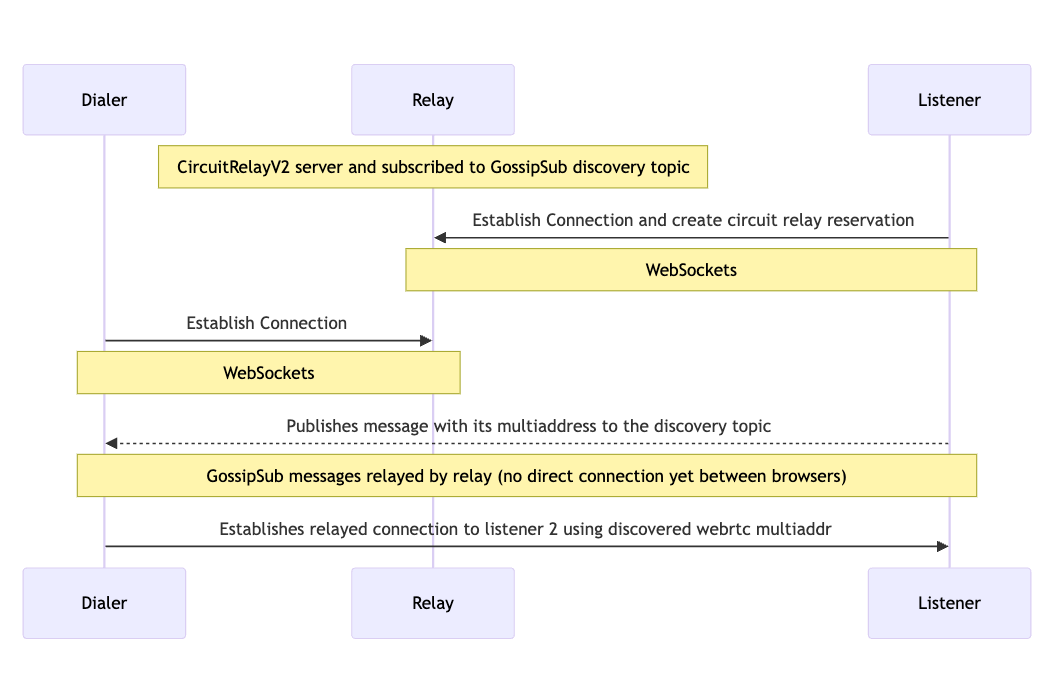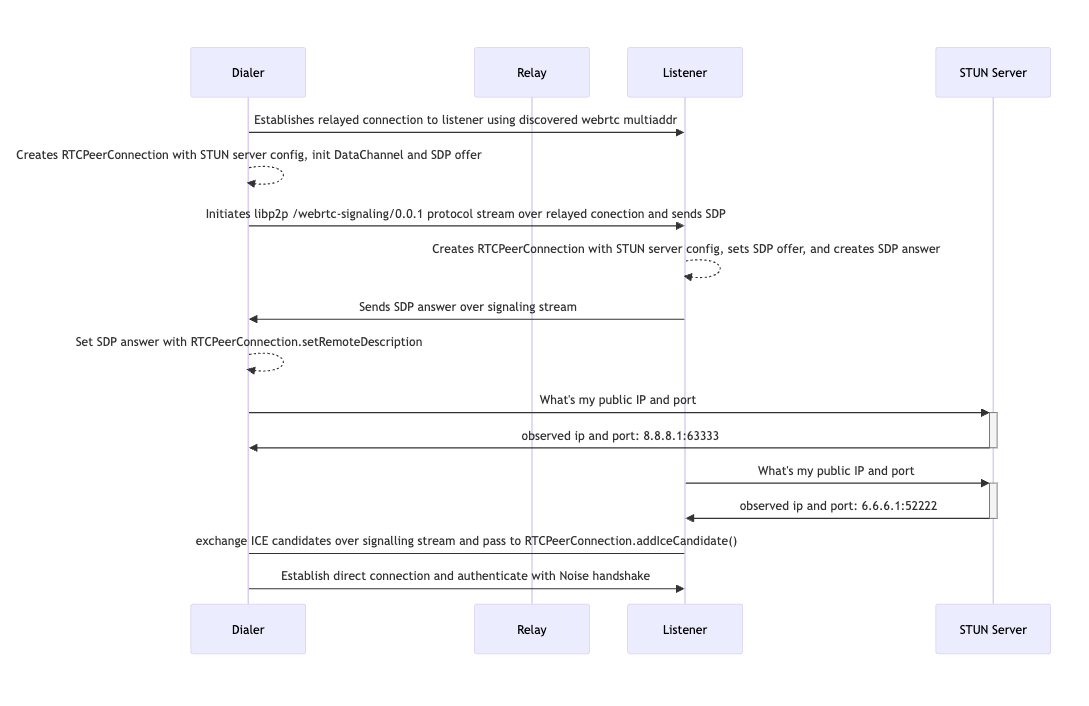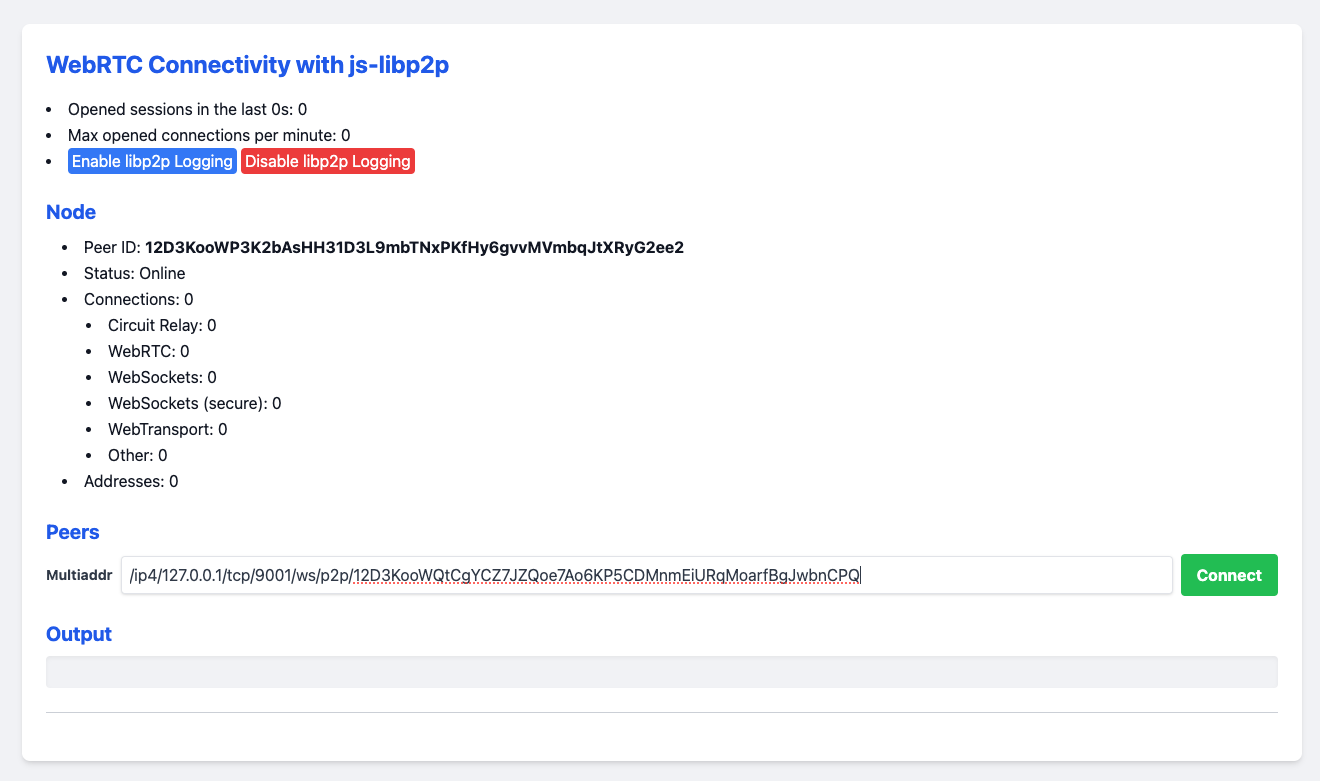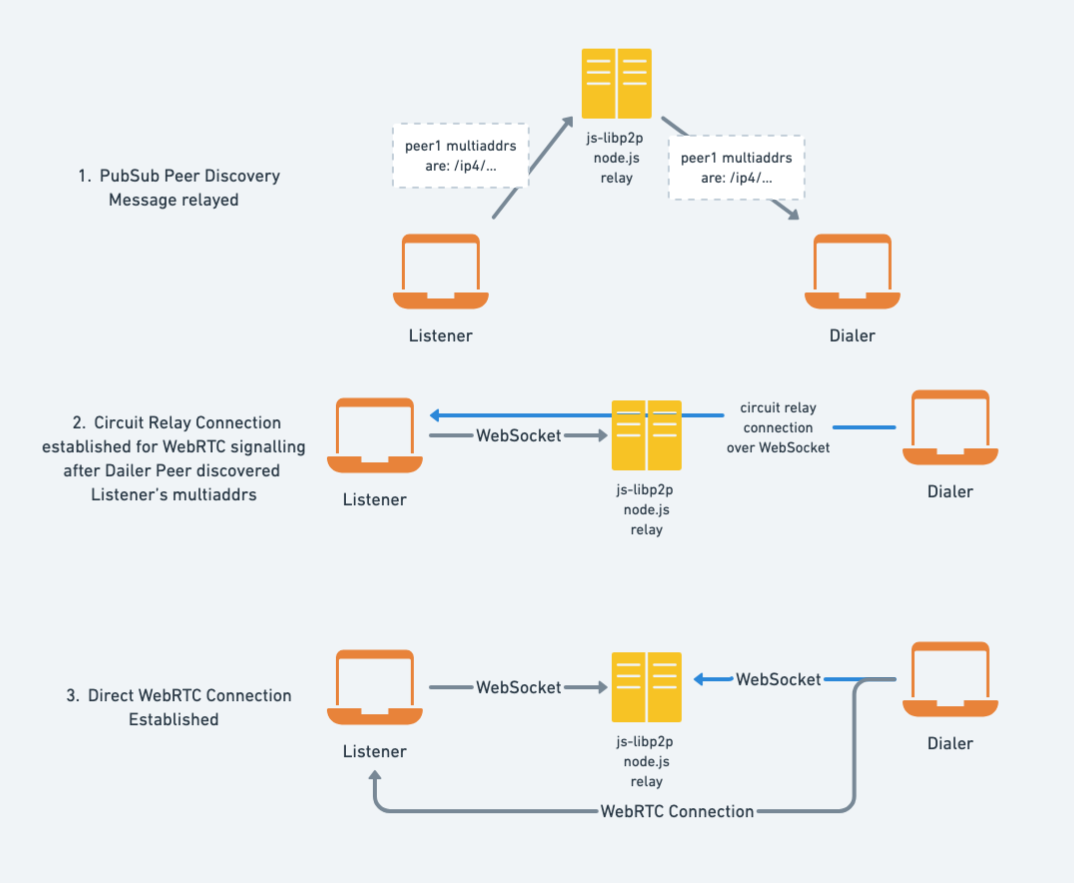WebRTC with js-libp2p
- Introduction
- Why WebRTC & libp2p
- Peer-to-peer connections: when two aren’t enough to tango
- Connection flow diagram
- Prerequisites
- Step 1: Clone the repository and install dependencies
- Step 2: Start the js-libp2p node.js relay
- Step 3: Start js-libp2p in the browser
- Step 4: Connect to the relay from the browser
- Step 5: Make the browser dialable with Circuit Relay
- Step 6: Set the relay in the browser app as a bootstrap peer
- Step 7: Listen on WebRTC and establish a direct connection
- Step 8: PubSub peer discovery
- Summary
- Final notes
- Next steps
On this page
- Introduction
- Why WebRTC & libp2p
- Peer-to-peer connections: when two aren’t enough to tango
- Connection flow diagram
- Prerequisites
- Step 1: Clone the repository and install dependencies
- Step 2: Start the js-libp2p node.js relay
- Step 3: Start js-libp2p in the browser
- Step 4: Connect to the relay from the browser
- Step 5: Make the browser dialable with Circuit Relay
- Step 6: Set the relay in the browser app as a bootstrap peer
- Step 7: Listen on WebRTC and establish a direct connection
- Step 8: PubSub peer discovery
- Summary
- Final notes
- Next steps
Introduction
In this guide, you will learn how to establish direct peer-to-peer (p2p) connections between browsers using js-libp2p and WebRTC.
Browser-to-browser connectivity is the foundation for distributed apps. When combined with GossipSub, like in the universal connectivity chat app, it gives you the building blocks for peer-to-peer event-based apps with mesh topologies.
By the end of the guide, you will be familiar with the requisite libp2p and WebRTC protocols and concepts and how to use them to establish libp2p connections between browsers. You can find the associated code for this guide on GitHub.
Since js-libp2p runs both in the browser and Node.js with WebRTC being supported in both, what’s covered in this guide also applies to using the WebRTC transport to dial browsers from Node.js.
WebRTC is a set of open standards and Web APIs that enable Web apps to establish direct connectivity for audio/video conferencing and exchanging arbitrary data. Today, WebRTC is supported by most browsers and powers a lot of popular web conferencing apps.
Both js-libp2p and WebRTC are quite complicated technologies due to the complex nature of peer-to-peer networking, browser standards, and security. In favor of brevity, this guide will skim over some details while linking out to relevant resources.
Why WebRTC & libp2p
WebRTC and libp2p can be used independently of each other. This begs the question, why use the two together? The TL;DR is that they complement each other.
WebRTC’s goal is to enable applications to establish direct connections between their users in the browser, i.e. peer-to-peer “browser-to-browser” connectivity.
Libp2p gives you the tools to build interoperable cross-platform peer-to-peer applications with mesh topologies that work both on the web and as stand-alone binaries.
Direct connections are especially useful for video and audio calling, because they allow traffic, i.e. the packets, to flow directly from one peer to another without an additional network hop to a server that may be geographically far (network latency is still bound to distances and the speed of light).
However, the reality of public internet networking—given routers, NAT layers, VPNs, and firewalls—is such that p2p connectivity is riddled with challenges. These are commonly overcome by running additional infrastructure such as signaling, STUN, and TURN servers, some of which are standardized as part of WebRTC.
While WebRTC is a solution to peer-to-peer connectivity in the context of browsers. Libp2p encompasses a wider scope with building blocks for constructing peer-to-peer apps that support WebRTC in addition to other transports, such as QUIC, TCP, WebSocket, WebTransport, and essentially form a mesh topology:

Another benefit of WebRTC and libp2p is that it allows you to dial a js-libp2p peer in the browser from a js-libp2p in Node.js.
The diagram above illustrates a mesh topology with libp2p, whereby each peer is identified by a Peer ID that is derived from a public key. When you create a new peer libp2p will first create a new public-private key pair, unless you provide one. Each Peer can have multiple addresses depending on the transport protocols it can be dialed with, e.g. WebRTC in the browser, which can also change.
Peer-to-peer connections: when two aren’t enough to tango
Perhaps the most important thing to note about WebRTC and the connection flow is that you need additional server(s) to establish a direct connection between two browsers. The role of these servers is to assist the two browsers in discovering their public IP address so that they can set up a direct connection.
Specifically, these include:
- STUN server: helps the browser discover its observed public address and is necessary in almost all cases, due to NAT making it hard for a browser to know its observed public IP. There are many free public STUN servers that you can use.
- TURN (Relay) server: relays traffic if the browsers fail to establish a direct connection and is defined as part of the WebRTC specification. Unlike signaling and STUN servers, TURN servers can be costly to run because they route all traffic between peers. This guide does not use TURN servers. Instead, it leans on GossipSub to ensure delivery of messages when direct connections cannot be established.
- Signaling: helps the browsers exchange SDP (Session Description Protocol) messages: the metadata necessary to establish a connection. Most importantly, signaling is not part of the WebRTC specification. This means that applications are free to implement signaling as they see fit. In this guide, you will use Libp2p’s protocol for signaling over Circuit Relay v2 connections.
- Libp2p relay: The libp2p peer serves two roles:
- Circuit Relay V2: A publicly reachable libp2p peer that can serve as a relay between browser nodes that have yet to establish a direct connection between each other. Unlike TURN servers, which are WebRTC-specific and can be costly to run, Circuit Relay V2 is a libp2p protocol that is resource-constrained by design. It’s also decentralized and trustless, in the sense that any publicly reachable libp2p peer supporting the protocol can help browser-based libp2p nodes by serving as a (time and bandwidth-constrained) relay.
- PubSub Peer Discovery: For browser peers to discover each other, they require a mechanism to announce their multiaddresses to other libp2p peers, including browsers. GossipSub is a PubSub implementation that helps by relaying those peer discovery messages between browsers, kicking off the direct connection establishment. Note that this approach to peer discovery is not very scalable and probably not fit for production use cases.
In summary, as part of this guide, you will learn how to run a publicly reachable, long-running libp2p peer that serves as both a circuit relay and a GossipSub message relay. This guide refer to that libp2p peer as the “relay” or “bootstrapper” peer depending on the context.
Connection flow diagram
The following diagrams visualize the connection flow between two browsers using js-libp2p and WebRTC.
The first diagram illustrates the peer discovery and establishment of a relayed connection between the two browsers:

The second diagram, which continues from the first, illustrates the SDP handshake via the Circuit Relay:

The connection flow seems complex, but thankfully, libp2p abstracts away some of that complexity and the rest is explained in this guide.
Either way, there are several noteworthy things about the connection flow:
- There’s no prescribed mechanism in libp2p for how the two peers discover each other’s multiaddress; this is also known as “peer discovery”. This guide uses a dedicated GossipSub channel for the application where you publish your multiaddrs (periodically) similar to mdns. PubSub peer discovery works well for demos and guides, but its current design is not battle-tested for production use cases at scale.
- Other approaches to Peer routing and discovery include DHT FIND_NODE query, HTTP Delegated Routing, and GossipSub Peer Exchange, though browser peers don’t tend to be long-lived enough to appear in the results of the first two.
- Since this guide uses a GossipSub channel for peer discovery, the relay node listens to the discovery topic too so that it relays messages between browsers who’ve yet to establish a direct connection.
Prerequisites
- Node.js installed to build the frontend and to run the relay
- Chrome or Firefox, for WebTransport connectivity to the relay (Safari does not support WebTransport)
This guide assumes a basic understanding of libp2p concepts such as:
Besides that, most of this guide focuses on js-libp2p, i.e. JavaScript.
Step 1: Clone the repository and install dependencies
Clone the repository:
git clone https://github.com/libp2p/libp2p-webrtc-guide
Once the repository is cloned, enter the libp2p-webrtc-guide folder, and install the npm dependencies
cd libp2p-webrtc-guide
npm install
Step 2: Start the js-libp2p node.js relay
In this step, you start the node.js relay.
Run the following command:
npm run start:relay
It also outputs the PeerID and the multiaddrs it’s listening on and should look similar to:
PeerID: 12D3KooWQtCgYCZ7JZQoe7Ao6KP5CDMnmEiURqMoarfBgJwbnCPQ
Multiaddrs: [
Multiaddr(/ip4/127.0.0.1/tcp/9001/ws/p2p/12D3KooWQtCgYCZ7JZQoe7Ao6KP5CDMnmEiURqMoarfBgJwbnCPQ),
Multiaddr(/ip4/192.168.3.174/tcp/9001/ws/p2p/12D3KooWQtCgYCZ7JZQoe7Ao6KP5CDMnmEiURqMoarfBgJwbnCPQ),
Multiaddr(/ip4/127.0.0.1/tcp/9002/p2p/12D3KooWQtCgYCZ7JZQoe7Ao6KP5CDMnmEiURqMoarfBgJwbnCPQ),
Multiaddr(/ip4/192.168.3.174/tcp/9002/p2p/12D3KooWQtCgYCZ7JZQoe7Ao6KP5CDMnmEiURqMoarfBgJwbnCPQ)
]
Step 3: Start js-libp2p in the browser
In this step, you start the js-libp2p peer in the browser/
In a new terminal window, open the repository cloned in the previous step:
cd libp2p-webrtc-guide
Run the following command to start the frontend development server:
npm run start
The output contains the address of the local development server:
> Local: http://127.0.0.1:8000/
Next, open the src/index.js file in your code editor and find the call to createLibp2p:
const libp2p = await createLibp2p({
transports: [
webSockets(),
webTransport(),
webRTC(),
],
connectionEncrypters: [noise()],
streamMuxers: [yamux()],
connectionGater: {
// Allow private addresses for local testing
denyDialMultiaddr: async () => false,
},
services: {
identify: identify(),
},
});
The createLibp2p invocation creates a libp2p peer which has its associated key pair and Peer ID with support for the WebSocket , WebTransport and WebRTC transports, as well as the identify protocol. It also uses noise to ensure all connections are encrypted, and yamux as the stream multiplexer for the relayed connection.
Why is yamux needed?
You may notice that the above js-libp2p configuration adds yamux as the stream multiplexer. While both WebRTC and WebTransport come with native stream multiplexing, yamux is still required for WebSockets to multiplex streams on the circuit relay connection.

When a browser initiates the connection to another browser over a circuit relay, the underlying WebSocket stream to the relay is multiplexed by yamux and encrypted by Noise. In the case of WebTransport it is multiplexed and encrypted natively. Either way, the relayed connection between the two browsers must be encrypted by noise otherwise the relay could eavesdrop on the traffic. Once the relayed connection between the browsers is encrypted, it also requires yamux to create a stream for the signaling protocol.
This is the minimal configuration needed to establish a connection to the local relay.
Finally, open http://127.0.0.1:8000/ in your browser and you will see your Peer ID. This Peer ID is created automatically and persists in memory. Reloading the page results in a new PeerID
Step 4: Connect to the relay from the browser
In this step, you connect the browser js-libp2p peer to the node.js relay peer.
Open the frontend in your browser (or use the one open from the previous step) and enter the loopback WebSocket multiaddr of the relay, i.e. /ip4/127.0.0.1/tcp/9001/ws/p2p/12D3KooWQtCgYCZ7JZQoe7Ao6KP5CDMnmEiURqMoarfBgJwbnCPQ

Now click Connect and the peer should appear in the peer List:

Congratulations, you have now established a WebSocket connection to the relay.
Step 5: Make the browser dialable with Circuit Relay
In this step, you enable the circuit relay transport to make the browser dialable via the relay peer (that is already configured as a circuit relay server).
In the src/index.js file, update the call to createLibp2p as follows:
+import { circuitRelayTransport } from '@libp2p/circuit-relay-v2'
const libp2p = await createLibp2p({
+ addresses: {
+ listen: [
+ // 👇 Required to create circuit relay reservations in order to respond to incoming WebRTC connections
+ '/p2p-circuit',
+ ],
+ },
transports: [
webSockets(),
webTransport(),
webRTC(),
+ circuitRelayTransport(),
],
connectionEncrypters: [noise()],
streamMuxers: [yamux()],
connectionGater: {
// Allow private addresses for local testing
denyDialMultiaddr: async () => false,
},
services: {
identify: identify(),
},
})
If you reload the page and connect to the relay multiaddr (by copying the multiaddr of the relay from the terminal) notice that the browser peer now shows (depending on your network setup) four multiaddrs addresses (or two if you don’t have a private network IP) that look as follows:
/ip4/127.0.0.1/tcp/9001/ws/p2p/12D3KooWQtCgYCZ7JZQoe7Ao6KP5CDMnmEiURqMoarfBgJwbnCPQ/p2p-circuit/p2p/12D3KooWQny42bDJfqPoBfpd9qNw2HrqtUTStUmCgBktnDXhisW7
/ip4/192.168.3.174/tcp/9001/ws/p2p/12D3KooWQtCgYCZ7JZQoe7Ao6KP5CDMnmEiURqMoarfBgJwbnCPQ/p2p-circuit/p2p/12D3KooWQny42bDJfqPoBfpd9qNw2HrqtUTStUmCgBktnDXhisW7
/ip4/127.0.0.1/tcp/9002/p2p/12D3KooWQtCgYCZ7JZQoe7Ao6KP5CDMnmEiURqMoarfBgJwbnCPQ/p2p-circuit/p2p/12D3KooWQny42bDJfqPoBfpd9qNw2HrqtUTStUmCgBktnDXhisW7
/ip4/192.168.3.174/tcp/9002/p2p/12D3KooWQtCgYCZ7JZQoe7Ao6KP5CDMnmEiURqMoarfBgJwbnCPQ/p2p-circuit/p2p/12D3KooWQny42bDJfqPoBfpd9qNw2HrqtUTStUmCgBktnDXhisW7
For each network interface the relay binds to, there are two addresses: one TCP multiaddr and one WebSocket (denoted by ws in the multiaddr). This means that the browser is now dialable via both the localhost, private network over two transports: WebSockets and TCP.
Observe that the beginning of the multiaddr is the same as the relay, followed by /p2p-circuit/p2p/BROWSER_PEER_ID. This multiaddr can be used by other browser peers (capable of WebTransport) to connect to the first browser window using the relay:

By adding a circuitRelayTransport and configuring a /p2p-circuit listen address, js-libp2p was able to create circuit relay reservation (time and bandwidth-constrained) on the relay.
Testing circuit relay
To test dialing the browser with circuit relay:
- Copy the local WebSocket multiaddr (
127.0.0.1withws) relay address from the browser tab. - Open a second browser tab, paste the multiaddr and click Connect.
The second browser tab should connect to two peers, i.e. the relay and the browser. You should also see two Peer IDs appear in the list of peers.
Step 6: Set the relay in the browser app as a bootstrap peer
In this step you configure js-libp2p to automatically connect to the relay peer. In libp2p, peers that you automatically connect to are commonly bootstrap peers, hence the name of the module.
Update the src/index.js file as follows, making sure to replace the multiaddr with the one from your relay:
+import { bootstrap } from '@libp2p/bootstrap'
const libp2p = await createLibp2p({
addresses: {
listen: [
'/p2p-circuit',
],
},
transports: [
webSockets(),
webTransport(),
webRTC(),
circuitRelayTransport(),
],
connectionEncrypters: [noise()],
streamMuxers: [yamux()],
connectionGater: {
// Allow private addresses for local testing
denyDialMultiaddr: async () => false,
},
+ peerDiscovery: [
+ bootstrap({
+ // replace with your relay multiaddr
+ list: ['/ip4/127.0.0.1/tcp/9001/ws/p2p/12D3KooWQtCgYCZ7JZQoe7Ao6KP5CDMnmEiURqMoarfBgJwbnCPQ'],
+ }),
+ ]
services: {
identify: identify(),
},
})
Reload the page, and the peer automatically reconnects to the relay.
Step 7: Listen on WebRTC and establish a direct connection
In this step, the js-libp2p configuration is updated to listen for WebRTC connections.
In the src/index.js file, update the call to createLibp2p as follows:
const libp2p = await createLibp2p({
addresses: {
listen: [
'/p2p-circuit',
+ // 👇 Listen for webRTC connections
+ '/webrtc',
],
},
transports: [
webSockets(),
webTransport(),
webRTC(),
circuitRelayTransport(),
],
connectionEncrypters: [noise()],
streamMuxers: [yamux()],
connectionGater: {
// Allow private addresses for local testing
denyDialMultiaddr: async () => false,
},
peerDiscovery: [
bootstrap({
// replace with your relay multiaddr
list: ['/ip4/127.0.0.1/tcp/9001/ws/p2p/12D3KooWQtCgYCZ7JZQoe7Ao6KP5CDMnmEiURqMoarfBgJwbnCPQ'],
}),
]
services: {
identify: identify(),
},
})
With the change above, libp2p leverages circuit relays as the signalling channel for WebRTC connections.
Reload the frontend, and once again connect to the relay by copying its ws multiaddr from the terminal.
After connecting to the relay, the frontend renders four new multiaddrs that look like:
/ip4/127.0.0.1/tcp/9001/ws/p2p/12D3KooWQtCgYCZ7JZQoe7Ao6KP5CDMnmEiURqMoarfBgJwbnCPQ/p2p-circuit/webrtc/p2p/12D3KooWQny42bDJfqPoBfpd9qNw2HrqtUTStUmCgBktnDXhisW7
/ip4/192.168.3.174/tcp/9001/ws/p2p/12D3KooWQtCgYCZ7JZQoe7Ao6KP5CDMnmEiURqMoarfBgJwbnCPQ/p2p-circuit/webrtc/p2p/12D3KooWQny42bDJfqPoBfpd9qNw2HrqtUTStUmCgBktnDXhisW7
/ip4/127.0.0.1/tcp/9002/p2p/12D3KooWQtCgYCZ7JZQoe7Ao6KP5CDMnmEiURqMoarfBgJwbnCPQ/p2p-circuit/webrtc/p2p/12D3KooWQny42bDJfqPoBfpd9qNw2HrqtUTStUmCgBktnDXhisW7
/ip4/192.168.3.174/tcp/9002/p2p/12D3KooWQtCgYCZ7JZQoe7Ao6KP5CDMnmEiURqMoarfBgJwbnCPQ/p2p-circuit/webrtc/p2p/12D3KooWQny42bDJfqPoBfpd9qNw2HrqtUTStUmCgBktnDXhisW7
These new multiaddrs all contain /webrtc/ meaning they are intended for establishing a direct WebRTC connection between two browsers. The first two are relevant for the browser, since they are WebSocket multiaddrs.
Copy the first multiaddr that contains: .../ws/p2p/RELAY_PEER_ID/p2p-circuit/webrtc/p2p/BROWSER_PEER_ID, open another browser window, and paste the multiaddr into the input, and click Connect.
Once the connection succeeds, the WebRTC connection count in both browsers is 1 and both browsers are connected to the relay as well as the other browser Peer ID:

Congratulations! You have successfully established a direct connection between two browsers.
Exchanging multiaddrs manually is cumbersome. To avoid this, let’s introduce PubSub-based peer discovery in the next step.
Step 8: PubSub peer discovery
In the previous steps, you worked through the process of establishing a WebRTC connection by manually copying the multiaddrs.
In this step, PubSub peer discovery is introduced so the browsers can exchange their multiaddrs and discover each other automatically (with the help of the relay).
In libp2p, PubSub is implemented with the GossipSub protocol, which provides an efficient way for mesh networks to exchange messages.
For PubSub peer discovery to work, both frontend and the relay must use the same topic. As soon as the frontend discovers its own multiaddrs, it publishes it in a message to the discovery topic. The relay, which is also listening to the discovery topic, gossips the message to other browser peers connected to it, which in turn, establish direct WebRTC connections. From a high level, it looks as follows:

In the src/index.js file, update the call to createLibp2p as follows:
+import { gossipsub } from '@chainsafe/libp2p-gossipsub'
+import { pubsubPeerDiscovery } from '@libp2p/pubsub-peer-discovery'
+import { PUBSUB_PEER_DISCOVERY } from './constants.js'
const libp2p = await createLibp2p({
addresses: {
listen: [
'/p2p-circuit',
'/webrtc',
],
},
transports: [
webSockets(),
webTransport(),
webRTC(),
circuitRelayTransport(),
],
connectionEncrypters: [noise()],
streamMuxers: [yamux()],
connectionGater: {
// Allow private addresses for local testing
denyDialMultiaddr: async () => false,
},
peerDiscovery: [
bootstrap({
// replace with your relay multiaddr
list: ['/ip4/127.0.0.1/tcp/9001/ws/p2p/12D3KooWQtCgYCZ7JZQoe7Ao6KP5CDMnmEiURqMoarfBgJwbnCPQ'],
}),
+ pubsubPeerDiscovery({
+ // Every 10 seconds publish our multiaddrs
+ interval: 10_000,
+ // The topic that the relay is also subscribed to
+ topics: [PUBSUB_PEER_DISCOVERY],
+ }),
],
services: {
+ pubsub: gossipsub(),
identify: identify(),
},
})
+libp2p.addEventListener('peer:discovery', async (evt) => {
+ // Encapsulate the peer ID to ensure dialing succeeds
+ // Should be removed once https://github.com/libp2p/js-libp2p/issues/3239 is resolved.
+ const maddrs = evt.detail.multiaddrs.map((ma) => ma.encapsulate(`/p2p/${evt.detail.id.toString()}`))
+ console.log(
+ `Discovered new peer (${evt.detail.id.toString()}). Dialling:`, maddrs.map((ma) => ma.toString()),
+ )
+ try {
+ await libp2p.dial(maddrs)
+ } catch (err) {
+ console.error(`Failed to dial peer (${evt.detail.id.toString()}):`, err)
+ }
+})
A couple of note-worthy things about these changes:
- The
pubsubservice adds GossipSub protocol capabilities to the node. pubsubPeerDiscoverydepends on thepubsubservice and introduces the peer discovery mechanism. GossipSub is a large dependency making it suboptimal for browser bundles.- When js-libp2p discovers a new peer (and its multiaddrs) it emits a
peer:discoveryevent. - To dial a newly discovered peer, add an event listener for the
peer:discoveryevent and dial the peer with thedialmethod. - PubSub peer discovery works well for demos and guides, but its current design is not battle-tested for production use cases.
Next, open two browser tabs of the frontend, and you should see them connected to each other within a couple of seconds 🎉.
Summary
If you have reached this far in the guide, well done! You learned how to establish browser-to-browser connectivity with libp2p and WebRTC and how libp2p abstracts aspects of WebRTC like signaling and SDP exchange. You also learned about js-libp2p’s configuration options and concepts such as Peer IDs, Multiaddrs, and GossipSub.
Final notes
NAT hole punching
Peer-to-peer connectivity is inherently hard, which is why in this guide, all connections were on a local machine which significantly increases connection success rates.
On public networks where both browser peers are behind NAT, NAT hole punching success rates range around 80% depending on the network conditions and the types of NAT the peers are behind. The implications of this depend on the nature of your app. PubSub with GossipSub is designed to ensure the delivery of messages without requiring a connection to the whole mesh. In other words, the GossipSub protocol is designed with sparsely-connected networks, where you are not connected to all other peers. So long as the browser peer can publish a message to at least one other peer, the message propagates to all subscribers.
Another approach is to introduce a TURN server, however, TURN servers tend to be complex to run, bandwidth-heavy, and prone to abuse, since they relay all traffic.
If you want to experiment with this example over public networks, the relay peer must be publicly reachable, i.e. have a public IP that is dialable by browser peers.
Differences between js-libp2p in Node.js and browser
Connectivity between the browser and relay is constrained by supported transports of the browser and the specific libp2p implementation.
At the time of writing, js-libp2p in browsers supports:
- WebSocket: this works well and is broadly adopted by libp2p implementations, but requires the relay to have CA-signed TLS certificate and a domain name to work in Secure Contexts. Another disadvantage of Secure WebSocket is that it results in double encryption (TLS and Noise) with libp2p.
- WebTransport: Supported by Chrome, Firefox, Opera, and Edge, but not Safari.
- WebRTC: Supported by most browsers
- WebRTC-direct: Supported by all browsers that support WebRTC.
While js-libp2p in Node.js supports:
- WebRTC: this one is rather confusing because unlike WebRTC direct, it requires an additional circuit relay peer to forward SDP messages between the browser and the Node.js relay, making it infeasible for the Node.js peer to be the relay. WebRTC-direct solves this problem, however, at the time of writing it isn’t supported by js-libp2p (See tracking issue).
- WebSocket: as mentioned above, requires a CA-signed TLS certificate and a domain.
- TCP: not available in browsers.
Therefore, until WebRTC-Direct or WebTransport support is added to js-libp2p in Node.js, it’s much easier to use go-libp2p.
Next steps
As a next step, the universal connectivity app can be a great learning resource, as it expands on many of the concepts and patterns implemented by this guide, in addition to having two bootstrapper implementations in Rust and Go.
Try the go-libp2p relay with WebTransport
Go into the go-relay directory and install dependencies
cd go-relay
go get .
From the go-relay folder, run the following command to compile and run the relay:
go run .
This compiles and runs the relay. It also outputs the PeerID and the multiaddrs it’s listening on. The output looks similar to:
2024/05/21 17:43:43 PeerID: 12D3KooWMEZEwzATAoXFbPmb1kgD7p4Ue3jzHGQ8ti2UrsFg11YJ
2024/05/21 17:43:43 Listening on: /ip4/127.0.0.1/udp/9095/quic-v1/p2p/12D3KooWMEZEwzATAoXFbPmb1kgD7p4Ue3jzHGQ8ti2UrsFg11YJ
2024/05/21 17:43:43 Listening on: /ip4/127.0.0.1/udp/9095/quic-v1/webtransport/certhash/uEiAbhhQxJeJ6nAWdpB6NdSV4UPaTwEcy9eA76p22SoKyvg/certhash/uEiBTPUrn6BebjshxC80Uarqi4ZsMhrPPQNu2RDu1N4n_Ww/p2p/12D3KooWMEZEwzATAoXFbPmb1kgD7p4Ue3jzHGQ8ti2UrsFg11YJ
2024/05/21 17:43:43 Listening on: /ip4/192.168.3.174/udp/9095/quic-v1/p2p/12D3KooWMEZEwzATAoXFbPmb1kgD7p4Ue3jzHGQ8ti2UrsFg11YJ
2024/05/21 17:43:43 Listening on: /ip4/192.168.3.174/udp/9095/quic-v1/webtransport/certhash/uEiAbhhQxJeJ6nAWdpB6NdSV4UPaTwEcy9eA76p22SoKyvg/certhash/uEiBTPUrn6BebjshxC80Uarqi4ZsMhrPPQNu2RDu1N4n_Ww/p2p/12D3KooWMEZEwzATAoXFbPmb1kgD7p4Ue3jzHGQ8ti2UrsFg11YJ
Note that it’s listening on two interfaces (the loopback and the private network) and two transports: QUIC and WebTransport (which is on top of QUIC). QUIC can be used for connections to other go-libp2p relays, while WebTransport for connections from browsers. That means that QUIC isn’t strictly necessary, but it’s useful if you deploy another relay for resilience or leverage the DHT for peer discovery.
Ephemeral WebTransport multiaddr
Another thing worth noting is that the WebTransport multiaddr contains two certificate hashes. These are needed by the browser to verify a self-signed certificate of the go-relay peer. Unlike CA-signed certificates, self-signed certificates can be created on the fly without interaction with a certificate authority.
So why two certificate hashes? Self-signed certificates are valid for at most 14 days. So by convention, go-libp2p generates two consecutively valid certificates to ensure a smooth transition when a new certificate is rolled out.
Another challenge you may face is that the WebTransport multiaddr that is hardcoded into the js-libp2p configuration is ephemeral and valid for around 28 days (2 certificate hashes valid for 14 days each). One way to address this is using the DHT to resolve the Peer ID (which is stable and would be hard coded in the frontend) to its latest multiaddrs as done by the universal connectivity app.